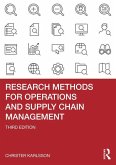Hospital Logistics and E-Management
Digital Transition and Revolution
Herausgeber: Blua, Philippe; Laplanche, David; de Block, Michael; Amodeo, Lionel; Yalaoui, Farouk
Hospital Logistics and E-Management
Digital Transition and Revolution
Herausgeber: Blua, Philippe; Laplanche, David; de Block, Michael; Amodeo, Lionel; Yalaoui, Farouk
- Gebundenes Buch
- Merkliste
- Auf die Merkliste
- Bewerten Bewerten
- Teilen
- Produkt teilen
- Produkterinnerung
- Produkterinnerung
As new information and communication technologies (NICTs) increasingly reorganize our practices and influence our daily lives, there is a pressing need to study their impact in the field of hospital logistics and to question their future use. Hospital Logistics and e-Management presents an inventory of the health information system, and deals with informational and logistical issues with regard to medical information. Through two case studies of hospital logistics systems which have drawn on academic research, this book examines how powerful decision support tools can improve the quality of…mehr
Andere Kunden interessierten sich auch für
![Sustainable Logistics and Supply Chain Management Sustainable Logistics and Supply Chain Management]() David B. GrantSustainable Logistics and Supply Chain Management55,99 €
David B. GrantSustainable Logistics and Supply Chain Management55,99 €![Research Methods for Operations and Supply Chain Management Research Methods for Operations and Supply Chain Management]() Research Methods for Operations and Supply Chain Management65,99 €
Research Methods for Operations and Supply Chain Management65,99 €![Logistics and Retail Management Logistics and Retail Management]() Logistics and Retail Management87,99 €
Logistics and Retail Management87,99 €![Supply Chain Leadership Supply Chain Leadership]() Peter W. RobertsonSupply Chain Leadership51,99 €
Peter W. RobertsonSupply Chain Leadership51,99 €![Restaurant Success by the Numbers: A Money-Guy's Guide to Opening the Next New Hot Spot Restaurant Success by the Numbers: A Money-Guy's Guide to Opening the Next New Hot Spot]() Roger FieldsRestaurant Success by the Numbers: A Money-Guy's Guide to Opening the Next New Hot Spot16,99 €
Roger FieldsRestaurant Success by the Numbers: A Money-Guy's Guide to Opening the Next New Hot Spot16,99 €![Food Supply Chain Management and Logistics Food Supply Chain Management and Logistics]() Samir DaniFood Supply Chain Management and Logistics74,99 €
Samir DaniFood Supply Chain Management and Logistics74,99 €![Supply Chain and Logistics Management Supply Chain and Logistics Management]() Supply Chain and Logistics Management354,99 €
Supply Chain and Logistics Management354,99 €-
-
-
As new information and communication technologies (NICTs) increasingly reorganize our practices and influence our daily lives, there is a pressing need to study their impact in the field of hospital logistics and to question their future use. Hospital Logistics and e-Management presents an inventory of the health information system, and deals with informational and logistical issues with regard to medical information. Through two case studies of hospital logistics systems which have drawn on academic research, this book examines how powerful decision support tools can improve the quality of patient service and logistics organization. The first case study deals with the influx of patients to emergency services and service organization, and the second with the optimization of product collection and distribution flows.
Hinweis: Dieser Artikel kann nur an eine deutsche Lieferadresse ausgeliefert werden.
Hinweis: Dieser Artikel kann nur an eine deutsche Lieferadresse ausgeliefert werden.
Produktdetails
- Produktdetails
- Verlag: ISTE Ltd and John Wiley & Sons Inc
- Seitenzahl: 208
- Erscheinungstermin: 12. Dezember 2019
- Englisch
- Abmessung: 231mm x 155mm x 18mm
- Gewicht: 382g
- ISBN-13: 9781786305008
- ISBN-10: 1786305003
- Artikelnr.: 57705717
- Herstellerkennzeichnung
- Libri GmbH
- Europaallee 1
- 36244 Bad Hersfeld
- gpsr@libri.de
- Verlag: ISTE Ltd and John Wiley & Sons Inc
- Seitenzahl: 208
- Erscheinungstermin: 12. Dezember 2019
- Englisch
- Abmessung: 231mm x 155mm x 18mm
- Gewicht: 382g
- ISBN-13: 9781786305008
- ISBN-10: 1786305003
- Artikelnr.: 57705717
- Herstellerkennzeichnung
- Libri GmbH
- Europaallee 1
- 36244 Bad Hersfeld
- gpsr@libri.de
Philippe Blua is Director of the Champagne Sud hospitals in France. Farouk Yalaoui is a Full Professor at the University of Technology of Troyes, France, and Director of the Institute of Services and Industries of the Future of Troyes. Lionel Amodeo is a Full Professor at the University of Technology of Troyes and Head of the Industrial System Optimization research team. Michaël De Block is Director of Information Systems at the Metz-Thionville CHR and GHT Lorraine Nord. David Laplanche is a doctor in the region of Aube in France and Head of the territorial division for medical information at the Champagne Sud hospitals.
Preface ix
Chapter 1. Hospitals and Management 1
Philippe BLUA
1.1. Introduction 1
1.2. Imperfections in hospital information technology 2
1.3. Essentials for high-quality IT systems in hospitals 5
1.4. Hospital IT systems of the future 7
1.5. Conclusion 11
1.6. References 12
Chapter 2. The Hospital and its IT System: Where it is Right Now and What
it Needs 13
Michaël DE BLOCK
2.1. Introduction 13
2.2. Cooperation and quality 18
2.2.1. Area 1 18
2.2.2. Area 2 19
2.2.3. Area 3 20
2.2.4. Area 4 21
2.2.5. Area 5 21
2.2.6. Axe 6 22
2.2.7. Area 7 23
2.2.8. Area 8 24
2.3. Information systems - communication and organization 26
2.4. Linking HIS, biomedicine and telemedicine 28
2.5. Conclusion 34
2.6. References 34
Chapter 3. Medical Informatics: Historical Overview, Supports and
Challenges 37
David LAPLANCHE and Stéphane SANCHEZ
3.1. Introduction 37
3.2. Information sources 38
3.2.1. Data that can be used in the hospital sector 38
3.2.2. Different media 39
3.2.3. Legal framework 40
3.2.4. Digital transition 43
3.3. Using information 45
3.3.1. PMIS 45
3.3.2. Medical information in research 48
3.3.3. Structure and use: an example from an ER unit 49
3.4. Conclusion 51
3.5. References 51
Chapter 4. Challenges in Hospital Logistics: the Example of the Champagne
Sud Hospitals 53
Frédéric LUTZ
4.1. Introduction 53
4.2. Challenges facing care professionals 55
4.3. Challenges around safety and the continuity in supplies 58
4.3.1. The need for regularity in supplies 59
4.3.2. The need for flexibility and reactivity 63
4.3.3. Qualitative requirements in supply and removal chains 63
4.4. Challenges around the role played in enhancing the appeal of the
institution 63
4.5. Challenges surrounding economic optimization 64
4.5.1. Examples of optimization implementations 64
4.5.2. Challenges in optimizing logistics flow management tools 68
4.6. Challenges related to regional cooperation 69
4.6.1. Cooperative purchasing in the context of regional hospital consortia
69
4.6.2. Challenges around common supplies and storage 71
4.6.3. Challenges surrounding the pooling of pharmaceutical supplies 76
4.6.4. Challenges around pooling fleets of vehicles 78
4.7. Challenges surrounding the implementation of a regional supply chain
management 81
4.8. Conclusion 83
4.9. References 83
Chapter 5. Forecasting Patient Flows into Emergency Services 85
Mohamed AFILAL, Lionel AMODEO, Farouk YALAOUI and Frédéric DUGARDIN
5.1. Introduction 85
5.2. The problem statement 87
5.3. A state-of-the-art 89
5.3.1. Predictive models 89
5.3.2. Forecasting inflows into emergency services 92
5.3.3. Summary 93
5.4. Analysis of the inflows of patients into emergency care 94
5.4.1. Data extraction 94
5.4.2. Data modeling 96
5.4.3. Descriptive statistics 98
5.5. Introduction of a new classification of patients in emergency care 100
5.5.1. Interest and motivation 102
5.5.2. Statistical approach 102
5.5.3. New classification: patient state 102
5.5.4. Descriptive statistics for the new categories 108
5.6. Forecast models for patient flows 108
5.6.1. The process used in the study 108
5.6.2. Types of forecasting models 109
5.6.3. Choosing classes to predict 114
5.6.4. Adjusted long-term forecasting model 116
5.6.5. Short-term forecasting models 119
5.7. Tests and implementation of the models 120
5.7.1. Testing the performance of the models 120
5.7.2. Analysis of the residuals 123
5.7.3. Analysis of the robustness of the model: epidemics 125
5.8. Application used in the ES of the THC: OptaUrgences® 126
5.8.1. Introduction 126
5.8.2. Specifications 126
5.8.3. Implementation: development of algorithms 131
5.8.4. Example of the use of this application 132
5.8.5. History of the performances 134
5.9. Conclusion 135
5.10. References 137
Chapter 6. Positioning and Innovations from the Champagne Sud Hospitals in
the World of Hospital Logistics 145
Moïse NOUMBISSI TCHOUPO, Alice YALAOUI, Lionel AMODEO and Farouk YALAOUI
6.1. Introduction 145
6.2. The hospital logistics problem 148
6.2.1. Operational research and the hospital world 149
6.2.2. Description, formalization and solution approach 150
6.3. Innovative methods and techniques 155
6.3.1. The problem of pickups and deliveries within a time frame and with a
homogeneous fleet of vehicles 155
6.3.2. Pickup and delivery problems with a time frame and a heterogeneous
fleet of vehicles of finite size 157
6.3.3. Pickup and delivery problem with a time frame and a heterogeneous
fleet of vehicles of infinite size 163
6.4. Conclusion 165
6.5. References 165
List of Authors 171
Index 173
Chapter 1. Hospitals and Management 1
Philippe BLUA
1.1. Introduction 1
1.2. Imperfections in hospital information technology 2
1.3. Essentials for high-quality IT systems in hospitals 5
1.4. Hospital IT systems of the future 7
1.5. Conclusion 11
1.6. References 12
Chapter 2. The Hospital and its IT System: Where it is Right Now and What
it Needs 13
Michaël DE BLOCK
2.1. Introduction 13
2.2. Cooperation and quality 18
2.2.1. Area 1 18
2.2.2. Area 2 19
2.2.3. Area 3 20
2.2.4. Area 4 21
2.2.5. Area 5 21
2.2.6. Axe 6 22
2.2.7. Area 7 23
2.2.8. Area 8 24
2.3. Information systems - communication and organization 26
2.4. Linking HIS, biomedicine and telemedicine 28
2.5. Conclusion 34
2.6. References 34
Chapter 3. Medical Informatics: Historical Overview, Supports and
Challenges 37
David LAPLANCHE and Stéphane SANCHEZ
3.1. Introduction 37
3.2. Information sources 38
3.2.1. Data that can be used in the hospital sector 38
3.2.2. Different media 39
3.2.3. Legal framework 40
3.2.4. Digital transition 43
3.3. Using information 45
3.3.1. PMIS 45
3.3.2. Medical information in research 48
3.3.3. Structure and use: an example from an ER unit 49
3.4. Conclusion 51
3.5. References 51
Chapter 4. Challenges in Hospital Logistics: the Example of the Champagne
Sud Hospitals 53
Frédéric LUTZ
4.1. Introduction 53
4.2. Challenges facing care professionals 55
4.3. Challenges around safety and the continuity in supplies 58
4.3.1. The need for regularity in supplies 59
4.3.2. The need for flexibility and reactivity 63
4.3.3. Qualitative requirements in supply and removal chains 63
4.4. Challenges around the role played in enhancing the appeal of the
institution 63
4.5. Challenges surrounding economic optimization 64
4.5.1. Examples of optimization implementations 64
4.5.2. Challenges in optimizing logistics flow management tools 68
4.6. Challenges related to regional cooperation 69
4.6.1. Cooperative purchasing in the context of regional hospital consortia
69
4.6.2. Challenges around common supplies and storage 71
4.6.3. Challenges surrounding the pooling of pharmaceutical supplies 76
4.6.4. Challenges around pooling fleets of vehicles 78
4.7. Challenges surrounding the implementation of a regional supply chain
management 81
4.8. Conclusion 83
4.9. References 83
Chapter 5. Forecasting Patient Flows into Emergency Services 85
Mohamed AFILAL, Lionel AMODEO, Farouk YALAOUI and Frédéric DUGARDIN
5.1. Introduction 85
5.2. The problem statement 87
5.3. A state-of-the-art 89
5.3.1. Predictive models 89
5.3.2. Forecasting inflows into emergency services 92
5.3.3. Summary 93
5.4. Analysis of the inflows of patients into emergency care 94
5.4.1. Data extraction 94
5.4.2. Data modeling 96
5.4.3. Descriptive statistics 98
5.5. Introduction of a new classification of patients in emergency care 100
5.5.1. Interest and motivation 102
5.5.2. Statistical approach 102
5.5.3. New classification: patient state 102
5.5.4. Descriptive statistics for the new categories 108
5.6. Forecast models for patient flows 108
5.6.1. The process used in the study 108
5.6.2. Types of forecasting models 109
5.6.3. Choosing classes to predict 114
5.6.4. Adjusted long-term forecasting model 116
5.6.5. Short-term forecasting models 119
5.7. Tests and implementation of the models 120
5.7.1. Testing the performance of the models 120
5.7.2. Analysis of the residuals 123
5.7.3. Analysis of the robustness of the model: epidemics 125
5.8. Application used in the ES of the THC: OptaUrgences® 126
5.8.1. Introduction 126
5.8.2. Specifications 126
5.8.3. Implementation: development of algorithms 131
5.8.4. Example of the use of this application 132
5.8.5. History of the performances 134
5.9. Conclusion 135
5.10. References 137
Chapter 6. Positioning and Innovations from the Champagne Sud Hospitals in
the World of Hospital Logistics 145
Moïse NOUMBISSI TCHOUPO, Alice YALAOUI, Lionel AMODEO and Farouk YALAOUI
6.1. Introduction 145
6.2. The hospital logistics problem 148
6.2.1. Operational research and the hospital world 149
6.2.2. Description, formalization and solution approach 150
6.3. Innovative methods and techniques 155
6.3.1. The problem of pickups and deliveries within a time frame and with a
homogeneous fleet of vehicles 155
6.3.2. Pickup and delivery problems with a time frame and a heterogeneous
fleet of vehicles of finite size 157
6.3.3. Pickup and delivery problem with a time frame and a heterogeneous
fleet of vehicles of infinite size 163
6.4. Conclusion 165
6.5. References 165
List of Authors 171
Index 173
Preface ix
Chapter 1. Hospitals and Management 1
Philippe BLUA
1.1. Introduction 1
1.2. Imperfections in hospital information technology 2
1.3. Essentials for high-quality IT systems in hospitals 5
1.4. Hospital IT systems of the future 7
1.5. Conclusion 11
1.6. References 12
Chapter 2. The Hospital and its IT System: Where it is Right Now and What
it Needs 13
Michaël DE BLOCK
2.1. Introduction 13
2.2. Cooperation and quality 18
2.2.1. Area 1 18
2.2.2. Area 2 19
2.2.3. Area 3 20
2.2.4. Area 4 21
2.2.5. Area 5 21
2.2.6. Axe 6 22
2.2.7. Area 7 23
2.2.8. Area 8 24
2.3. Information systems - communication and organization 26
2.4. Linking HIS, biomedicine and telemedicine 28
2.5. Conclusion 34
2.6. References 34
Chapter 3. Medical Informatics: Historical Overview, Supports and
Challenges 37
David LAPLANCHE and Stéphane SANCHEZ
3.1. Introduction 37
3.2. Information sources 38
3.2.1. Data that can be used in the hospital sector 38
3.2.2. Different media 39
3.2.3. Legal framework 40
3.2.4. Digital transition 43
3.3. Using information 45
3.3.1. PMIS 45
3.3.2. Medical information in research 48
3.3.3. Structure and use: an example from an ER unit 49
3.4. Conclusion 51
3.5. References 51
Chapter 4. Challenges in Hospital Logistics: the Example of the Champagne
Sud Hospitals 53
Frédéric LUTZ
4.1. Introduction 53
4.2. Challenges facing care professionals 55
4.3. Challenges around safety and the continuity in supplies 58
4.3.1. The need for regularity in supplies 59
4.3.2. The need for flexibility and reactivity 63
4.3.3. Qualitative requirements in supply and removal chains 63
4.4. Challenges around the role played in enhancing the appeal of the
institution 63
4.5. Challenges surrounding economic optimization 64
4.5.1. Examples of optimization implementations 64
4.5.2. Challenges in optimizing logistics flow management tools 68
4.6. Challenges related to regional cooperation 69
4.6.1. Cooperative purchasing in the context of regional hospital consortia
69
4.6.2. Challenges around common supplies and storage 71
4.6.3. Challenges surrounding the pooling of pharmaceutical supplies 76
4.6.4. Challenges around pooling fleets of vehicles 78
4.7. Challenges surrounding the implementation of a regional supply chain
management 81
4.8. Conclusion 83
4.9. References 83
Chapter 5. Forecasting Patient Flows into Emergency Services 85
Mohamed AFILAL, Lionel AMODEO, Farouk YALAOUI and Frédéric DUGARDIN
5.1. Introduction 85
5.2. The problem statement 87
5.3. A state-of-the-art 89
5.3.1. Predictive models 89
5.3.2. Forecasting inflows into emergency services 92
5.3.3. Summary 93
5.4. Analysis of the inflows of patients into emergency care 94
5.4.1. Data extraction 94
5.4.2. Data modeling 96
5.4.3. Descriptive statistics 98
5.5. Introduction of a new classification of patients in emergency care 100
5.5.1. Interest and motivation 102
5.5.2. Statistical approach 102
5.5.3. New classification: patient state 102
5.5.4. Descriptive statistics for the new categories 108
5.6. Forecast models for patient flows 108
5.6.1. The process used in the study 108
5.6.2. Types of forecasting models 109
5.6.3. Choosing classes to predict 114
5.6.4. Adjusted long-term forecasting model 116
5.6.5. Short-term forecasting models 119
5.7. Tests and implementation of the models 120
5.7.1. Testing the performance of the models 120
5.7.2. Analysis of the residuals 123
5.7.3. Analysis of the robustness of the model: epidemics 125
5.8. Application used in the ES of the THC: OptaUrgences® 126
5.8.1. Introduction 126
5.8.2. Specifications 126
5.8.3. Implementation: development of algorithms 131
5.8.4. Example of the use of this application 132
5.8.5. History of the performances 134
5.9. Conclusion 135
5.10. References 137
Chapter 6. Positioning and Innovations from the Champagne Sud Hospitals in
the World of Hospital Logistics 145
Moïse NOUMBISSI TCHOUPO, Alice YALAOUI, Lionel AMODEO and Farouk YALAOUI
6.1. Introduction 145
6.2. The hospital logistics problem 148
6.2.1. Operational research and the hospital world 149
6.2.2. Description, formalization and solution approach 150
6.3. Innovative methods and techniques 155
6.3.1. The problem of pickups and deliveries within a time frame and with a
homogeneous fleet of vehicles 155
6.3.2. Pickup and delivery problems with a time frame and a heterogeneous
fleet of vehicles of finite size 157
6.3.3. Pickup and delivery problem with a time frame and a heterogeneous
fleet of vehicles of infinite size 163
6.4. Conclusion 165
6.5. References 165
List of Authors 171
Index 173
Chapter 1. Hospitals and Management 1
Philippe BLUA
1.1. Introduction 1
1.2. Imperfections in hospital information technology 2
1.3. Essentials for high-quality IT systems in hospitals 5
1.4. Hospital IT systems of the future 7
1.5. Conclusion 11
1.6. References 12
Chapter 2. The Hospital and its IT System: Where it is Right Now and What
it Needs 13
Michaël DE BLOCK
2.1. Introduction 13
2.2. Cooperation and quality 18
2.2.1. Area 1 18
2.2.2. Area 2 19
2.2.3. Area 3 20
2.2.4. Area 4 21
2.2.5. Area 5 21
2.2.6. Axe 6 22
2.2.7. Area 7 23
2.2.8. Area 8 24
2.3. Information systems - communication and organization 26
2.4. Linking HIS, biomedicine and telemedicine 28
2.5. Conclusion 34
2.6. References 34
Chapter 3. Medical Informatics: Historical Overview, Supports and
Challenges 37
David LAPLANCHE and Stéphane SANCHEZ
3.1. Introduction 37
3.2. Information sources 38
3.2.1. Data that can be used in the hospital sector 38
3.2.2. Different media 39
3.2.3. Legal framework 40
3.2.4. Digital transition 43
3.3. Using information 45
3.3.1. PMIS 45
3.3.2. Medical information in research 48
3.3.3. Structure and use: an example from an ER unit 49
3.4. Conclusion 51
3.5. References 51
Chapter 4. Challenges in Hospital Logistics: the Example of the Champagne
Sud Hospitals 53
Frédéric LUTZ
4.1. Introduction 53
4.2. Challenges facing care professionals 55
4.3. Challenges around safety and the continuity in supplies 58
4.3.1. The need for regularity in supplies 59
4.3.2. The need for flexibility and reactivity 63
4.3.3. Qualitative requirements in supply and removal chains 63
4.4. Challenges around the role played in enhancing the appeal of the
institution 63
4.5. Challenges surrounding economic optimization 64
4.5.1. Examples of optimization implementations 64
4.5.2. Challenges in optimizing logistics flow management tools 68
4.6. Challenges related to regional cooperation 69
4.6.1. Cooperative purchasing in the context of regional hospital consortia
69
4.6.2. Challenges around common supplies and storage 71
4.6.3. Challenges surrounding the pooling of pharmaceutical supplies 76
4.6.4. Challenges around pooling fleets of vehicles 78
4.7. Challenges surrounding the implementation of a regional supply chain
management 81
4.8. Conclusion 83
4.9. References 83
Chapter 5. Forecasting Patient Flows into Emergency Services 85
Mohamed AFILAL, Lionel AMODEO, Farouk YALAOUI and Frédéric DUGARDIN
5.1. Introduction 85
5.2. The problem statement 87
5.3. A state-of-the-art 89
5.3.1. Predictive models 89
5.3.2. Forecasting inflows into emergency services 92
5.3.3. Summary 93
5.4. Analysis of the inflows of patients into emergency care 94
5.4.1. Data extraction 94
5.4.2. Data modeling 96
5.4.3. Descriptive statistics 98
5.5. Introduction of a new classification of patients in emergency care 100
5.5.1. Interest and motivation 102
5.5.2. Statistical approach 102
5.5.3. New classification: patient state 102
5.5.4. Descriptive statistics for the new categories 108
5.6. Forecast models for patient flows 108
5.6.1. The process used in the study 108
5.6.2. Types of forecasting models 109
5.6.3. Choosing classes to predict 114
5.6.4. Adjusted long-term forecasting model 116
5.6.5. Short-term forecasting models 119
5.7. Tests and implementation of the models 120
5.7.1. Testing the performance of the models 120
5.7.2. Analysis of the residuals 123
5.7.3. Analysis of the robustness of the model: epidemics 125
5.8. Application used in the ES of the THC: OptaUrgences® 126
5.8.1. Introduction 126
5.8.2. Specifications 126
5.8.3. Implementation: development of algorithms 131
5.8.4. Example of the use of this application 132
5.8.5. History of the performances 134
5.9. Conclusion 135
5.10. References 137
Chapter 6. Positioning and Innovations from the Champagne Sud Hospitals in
the World of Hospital Logistics 145
Moïse NOUMBISSI TCHOUPO, Alice YALAOUI, Lionel AMODEO and Farouk YALAOUI
6.1. Introduction 145
6.2. The hospital logistics problem 148
6.2.1. Operational research and the hospital world 149
6.2.2. Description, formalization and solution approach 150
6.3. Innovative methods and techniques 155
6.3.1. The problem of pickups and deliveries within a time frame and with a
homogeneous fleet of vehicles 155
6.3.2. Pickup and delivery problems with a time frame and a heterogeneous
fleet of vehicles of finite size 157
6.3.3. Pickup and delivery problem with a time frame and a heterogeneous
fleet of vehicles of infinite size 163
6.4. Conclusion 165
6.5. References 165
List of Authors 171
Index 173








